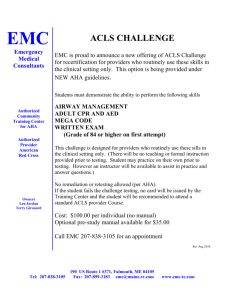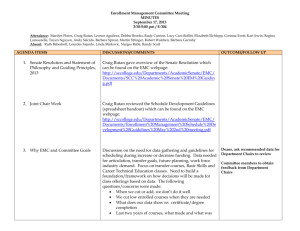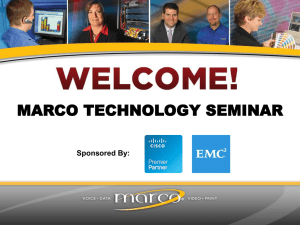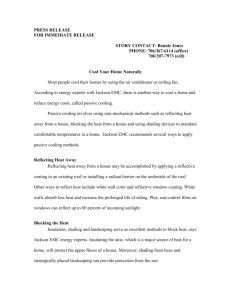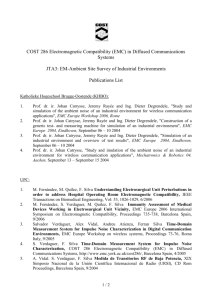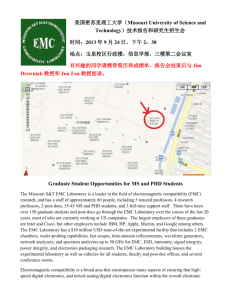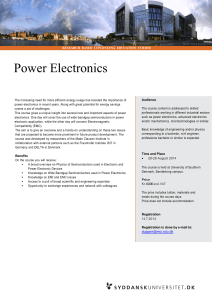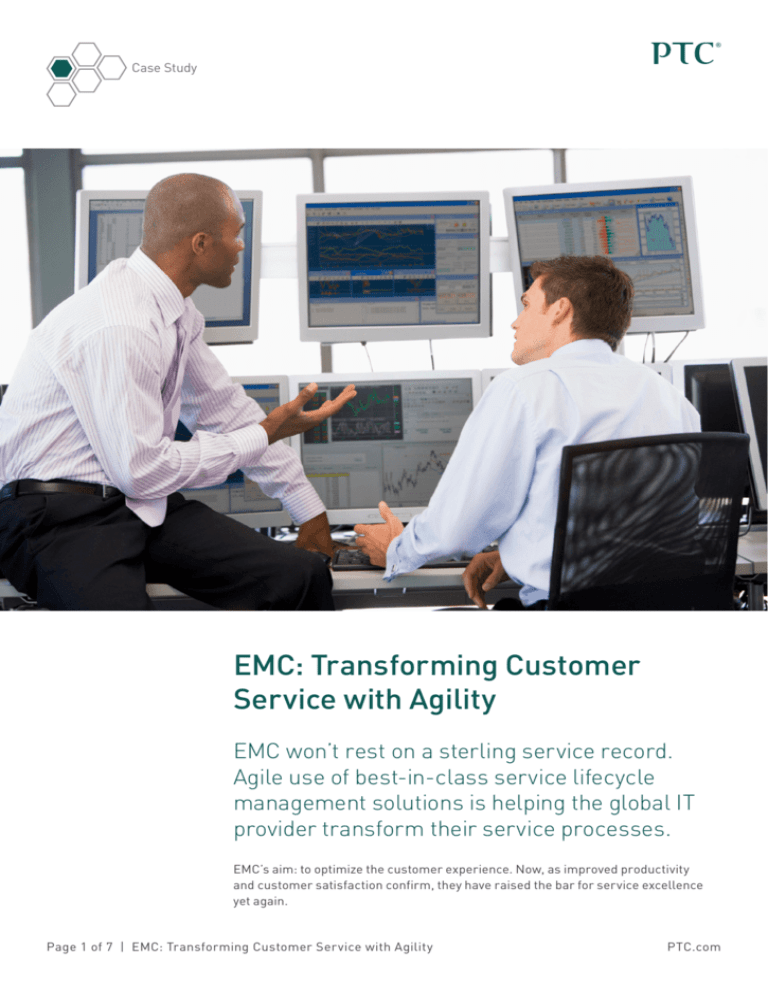
Case Study
EMC: Transforming Customer
Service with Agility
EMC won’t rest on a sterling service record.
Agile use of best-in-class service lifecycle
management solutions is helping the global IT
provider transform their service processes.
EMC’s aim: to optimize the customer experience. Now, as improved productivity
and customer satisfaction confirm, they have raised the bar for service excellence
yet again.
Page 1 of 7 | EMC: Transforming Customer Service with Agility
PTC.com
Case Study
EMC Corporation has long been known for their high quality of customer service.
Just ask the Technology Services Industry Association (TSIA). They have recognized
EMC with 23 STAR Awards, across all service disciplines, over the past 12 years.
EMC and Cisco are the only technology companies to earn the TSIA’s prestigious Hall
of Fame Lifetime Achievement Award four times.
Yet the recognition for EMC’s service leadership hardly ends there. This US-based
multinational company is a global leader in enabling businesses and service
providers to transform their operations and deliver information technology as a
service (ITaaS). In enterprises ranging from small and medium-sized companies
to the FORTUNE 500, IT departments utilize EMC’s technology and services to
accelerate their journey to cloud computing and to store, manage, protect, and
analyze their most valuable asset, information, all in a more agile, trusted, and costefficient way.
Fundamentally, EMC’s transformation solutions enable customers to stay ahead of
the competition, so it is entirely fitting that EMC’s service teams are themselves now
focused so intently on their own process transformation. They know it is essential to
continue providing a customer experience that is second to none.
Metrics aligned to goals
EMC’s “customer first” culture is at the core of their service difference, and is a vital
component of the company’s growth strategy. “High quality of service is a primary
reason customers prefer us,” says David Matson, Principal Offer Marketing Manager
at EMC. “But we never want to get complacent. That’s why we’ve worked so hard to
transform our service processes for the better.”
EMC’s service transformation priority is to optimize the Total Customer Experience
(TCE). The company strives to increase service productivity and improve customer
satisfaction even as their operations spread to further reaches of the globe and their
service activities grow.
“
A s our portfolio has expanded and customer needs
have grown, it has become increasingly critical
for us to optimize service delivery across many
different customer segments and differentiated
solutions.”
John Dodd
Director of Customer Service Operations at EMC
Page 2 of 7 | EMC: Transforming Customer Service with Agility
PTC.com
Case Study
And EMC doesn’t simply talk the talk on TCE. Service metrics are
tightly aligned with company objectives. Customers are consistently
surveyed on service performance (often aided by third parties to
assure objectivity) and EMC’s service people, from field level to
the executive ranks, are evaluated and compensated based on
TCE metrics.
EMC takes an agile approach toward their mission to transform
service. The company’s overarching goal is to deliver the right
service at the right time, to any customer, anywhere in the world,
through the channels and delivery methods of their choice.
How EMC achieves this service agility is key to their success. The
company utilizes strategically selected and carefully implemented
best-in-class service lifecycle management (SLM) solutions.
Zeroing in on SLM has helped EMC provide their customers with
the utmost in service value, while giving the company a critical
competitive advantage.
Global Services Transformation
“Fifteen years ago, EMC was mainly known for one product: data
storage,” says John Dodd, Director of Customer Service Operations
at EMC. “But as our portfolio has expanded and our customers’
needs have grown increasingly complex, it has become critical for
us to optimize our service delivery across many segments
and solutions.”
“
Dispatchers lacked information to get
the right person with the right skills
to the right place with right part. Field
service often had to make return trips.”
John Dodd
EMC kicked off the second round of their Global Services
Transformation (GST) initiative in 2009. At the time, the company
used largely manual service scheduling and dispatch processes.
Parts ordering practices varied from one territory to the next, and
were sometimes inefficient. Lack of centralized visibility into onsite
parts inventory and the use of less cost-efficient shipping options
pushed service delivery expenses needlessly high.
Page 3 of 7 | EMC: Transforming Customer Service with Agility
Solution at a glance
EMC’s recent service lifecycle management initiatives have focused on field service
management, parts planning, and mobility.
Their agile SLM approach provides:
• Consistent scheduling, dispatch, and
parts ordering processes across all
geographies
• Clear visibility into parts inventories and
available personnel for efficient planning
• Granular service data specific to parts and
resources, and time-stamped for tracking
• Real-time workflow extended to field
sales people, with mobile access to
parts data
• Integration with CRM, ERP, case
management, and other legacy systems
These capabilities help EMC get the
right service person to the right
location at the right time with the right
service information and parts. SLM’s
payback has been significant. Since fully
deploying the PTC solutions, EMC has:
• Increased service jobs per eight-hour shift
by over 60%
• Raised true usage of service resources to
over 80% of the average shift
• Reduced need for return trips from 20% of
service calls to just 5%
• Cut overall travel time for service by
nearly 50%
• Limited same-day shipping of parts to
save over $7 million annually
• Increase customer satisfaction, already
high, from about 90% to over 95%
PTC.com
Case Study
“At times,” says Dodd, “dispatchers lacked information
they needed to be sure of getting the right person with
the right skills to the right place with the right part.
Field service often had to make numerous return trips.
This only added to service costs that were already
climbing as a percent of margin.”
EMC’s service transformation vision called for global
deployment of consistent field service management
and service parts management systems across all
geographies. Specifically they aimed to:
“
Scheduling and dispatch are now
so tightly tied to mobile access
and parts planning that we can
truly optimize logistics.”
John Dodd
•Automate the creation and dispatch of field service
tickets. Integration with EMC’s legacy systems for
case management, CRM, ERP, and other enterprise
applications was required
•Automate and centralize the parts location and
ordering processes. This demanded smooth
interfaces to multiple
third-party logistics providers covering all corners of
the globe
•Extend control of real-time workflow to remote
service people. Mobile access to field service
management capabilities was to be provided
everywhere
EMC could see that their legacy systems alone were
not up to these service-centric demands. It would take
solutions designed expressly for large-scale service
operations, and EMC found just what they needed in
PTC’s industry-leading SLM offerings.
“In late 2010,” says Dodd, “we put a Field Service
Management and mobility pilot in place in our Northeast
and Canada Field Service Areas. By late 2011, we
had fully deployed the PTC platforms, fully enabling
centralized dispatch and parts ordering.”
Service data everywhere
EMC has melded the people and the processes – and,
with PTC’s help, the technology – to increase service
productivity. Per Dodd, “Scheduling and dispatch are
now so tightly tied to mobile access and parts planning
that we can truly optimize logistics. Skills-based routing
gets the right resources with the right availability to the
right locations.”
The PTC solutions merge data from disparate systems.
This gives EMC’s service managers and professionals a
single source of truth for coordinating their activities.
“The field service data coming from the mobility
solution is highly granular,” says Dodd. “It gives very
specific info on service parts and resource utilization,
and it’s time-stamped for easier tracking of service
tasks. We now have a rich source of service data
consistently at our fingertips to mine for insights and
improve our performance.”
Centralized visibility into available resources and
parts, combined with mobile access to SLM tools, has
empowered EMC’s field technicians to take greater
ownership of service responsibilities and outcomes.
Dodd cites this example from parts administration:
“Debriefing on parts used to be much more complicated
and time-consuming. After leaving the site of the
service event, the technician would need to log into
Page 4 of 7 | EMC: Transforming Customer Service with Agility
PTC.com
Case Study
our case management system and enter serial numbers and parts
usage information manually. Multiple parts debriefs were batched
to remote resources for processing due to errors.”
“
Data is highly granular. It’s specific
to service parts and resources, and
it’s time-stamped for easy tracking of
service tasks.”
John Dodd
Dodd continues: “Now our field people can debrief parts data in
real-time from their mobile devices at the same time they service
our products. They enter information on parts used right at the
point of service. Then it’s instantly relayed to corporate to enable
improved failure analysis. This has not only simplified the debrief
process, it has also improved the accuracy of data.”
Savings in time and cost
Storm-Tested and Certified Strong
In 2012, Hurricane Sandy not only tested
the resolve of residents, communities, and
businesses along America’s mid-Atlantic
coast, but it also provided the first crisis test
for EMC’s new service lifecycle management
solutions. Fortunately, all came through the
mammoth storm standing even stronger
than before.
Many of EMC’s largest customers were in
the path that Sandy eventually took. As the
storm loomed, massive outages in power
and Internet access could be anticipated, and
the company’s regional parts depots were
at risk. EMC service managers, facilitated
by field service management tools, devised
a comprehensive response plan that put
emergency service resources on standby
around the globe. Specifically, the company
prepared by:
• Identifying additional customer engineers,
support specialists, and service
technicians from EMC’s US West, US
Central, and Canadian regions to be at
the ready
By automating so much of EMC’s field service and parts
management functions, SLM tools have freed the company’s
service technicians from administrative overhead to make better
use of their workdays.
• Strategically placing added resources in
hotels in critical areas in New York City,
New Jersey, and Philadelphia where the
concentration of EMC customers
is highest
“Before,” says Matson, “our service people were constantly getting
interrupted on the job. They’d have to schedule the next service visit
or place the next order for parts delivery. Now relieved of this, they
can give all of their attention to the service tasks at hand.”
• Moving pallets of critical service parts
to locations just outside of the storm’s
territory, with scheduling and dispatch
personnel added in Georgia and Utah
d
o
Pr
y
vit
ti
uc
Page 5 of 7 | EMC: Transforming Customer Service with Agility
EMC also added layers of communication.
They created a Wiki to report on power
availability, police activity, and other
emergency updates. Plus, managers
continually checked in with remote staff.
They used GPS to track service activities,
and contacted service people via cell phone
and text message to assure their safety
and wellbeing.
Deploying the field service management
tools, combined with clear communication
of the emergency plan, enabled EMC
to maintain effective customer service
before, during, and after the storm. Sandy’s
impact on EMC’s customers was effectively
minimized.
PTC.com
Case Study
As for SLM’s payback in productivity gains, the success metrics have been
eye-opening:
•Service jobs per eight-hour shift are up by 60%
•True usage of service resources has risen to over 80% of the average shift
•The need for return trips has dropped from 20% of service calls to just 5%
•Overall travel time for service has declined by nearly 50%
•Total activity in service parts administration is down by 66%
Cost savings are also impressive. Centralized planning and dispatch have
made it easier to align the service window with part shipment and determine if
necessary replacement parts are truly required on the same day. Since same-day
shipping costs typically demand a 70% premium, this has saved EMC some
$7 million annually.
Are EMC’s customers feeling the improvements as well? “Absolutely,” says Matson.
“We’ve made a lot of progress toward this. Customer satisfaction, which had already
reached 90%, has now increased to over 95%, and it continues to trend higher.”
“
Now field people access parts data from anywhere
they service our products. They enter information
on parts failure right at the point of service.”
John Dodd
Transformation’s lessons
Along the way to success, EMC’s service leaders have been gaining special insights
into the whats, whys, and hows of service transformation. They advise other largescale service organizations to:
•Limit solution customizations for different service regions. This reduces
overall complexity, and minimizes the risk of sub-optimum results from solution
variations
•Communicate all process and technology changes clearly and completely at
every level of the service organization, well in advance of the new solutions’
rollout
•Conduct robust interactive training and simulations, before solution deployment,
to help prepare all service teams for their new processes and targeted results
Page 6 of 7 | EMC: Transforming Customer Service with Agility
PTC.com
Case Study
•Apply an iterative approach to deployment using pilot programs
to incrementally tune application configurations, rules engines,
and business processes. This helps iron out the kinks and reduce
risks. Ultimately, it optimizes the benefits realized – step by
careful step.
•Always measure and manage workforce performance. Results
steadily improve when service teams stay focused on meeting
company targets for increased service productivity and improved
customer satisfaction
About EMC
• Number-one provider of storage solutions
for mission-critical applications
• IT solutions for cloud computing, Big Data,
backup and archive, content management,
and information management help
customers transform operations and
provide IT as a Service
Reactive to proactive
• Founded in 1979 by Richard J. Egan and
Roger Marino
How can EMC’s customers expect to enjoy even better service in
the future? Again, it’s the company’s “never rest” philosophy. EMC’s
service transformation journey continues.
• Headquarters in Hopkinton,
Massachusetts
“Our top priority,” Dodd says, “is to deliver service proactively to our
customers as effectively and efficiently as we deliver it reactively.
We’re aiming to be able to optimize our planned preventative service
with the same centralized and remote resources we use to optimize
response to our customers’ immediate service needs every day.”
This, adds Dodd, will require technology supporting a blended
workforce with more complex workflows, and that, he says, is why
SLM technology’s role at EMC will only grow more relevant:
“We’ll rely on SLM to help pull detailed service transaction data and
align our activities so our service managers and service technicians
everywhere are working together for our customers as one.”
• R&D centers in Brazil, China, France,
India, Ireland, Israel, the Netherlands,
Russia, Singapore, and the US
• Manufacturing facilities in the US
and Ireland
• Approximately 60,000 employees
worldwide
• Revenue of $21.7 billion in 2012 – highest
in company history – ranks 139 in the
FORTUNE 500
• Current Chairman and CEO: Joseph
M. Tucci
• NYSE: EMC; S&P 500 component
© 2014, PTC Inc. (PTC). All rights reserved. Information described herein is furnished for
informational use only, is subject to change without notice, and should not be taken as a guarantee,
commitment, condition or offer by PTC. PTC, the PTC logo, Product & Service Advantage, Creo,
Elements/Direct, Windchill, Mathcad and all other PTC product names and logos are trademarks or
registered trademarks of PTC and/or its subsidiaries in the United States and other countries. All
other product or company names are property of their respective owners.
J3225–Transforming Customer Service with Agility–EN–0214
Page 7 of 7 | EMC: Transforming Customer Service with Agility
PTC.com

